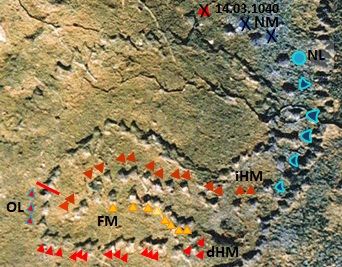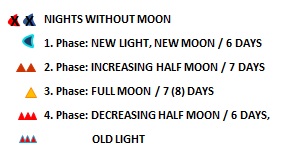This astronomical interpretation of a Canary petroglyph as a symbolic representation of a lunation initially required the compilation and evaluation of countless tables and diagrams of the numerous purely phenomenological visible characteristics of the moon. Then, finally, the most important features emerged which showed parallels to the shaping and the course of the impact marks of the rock engraving. This is because the periodically changing types of illumination of the moon in connection with its position next to the same fixed star are only repeated after 19 years in a very similar way on that particular day.
The surprising result of these investigations into how a native of the Canary Island La Palma might have observed the moon is shown in this publication in a simplified and perfectly understandable way.
According to the interpretation of this petroglyph of the archaeological site La Corujera / El Tendal a native of La Palma could have observed a lunar cycle and transferred it by impacts figuratively into the rock. Similar lunations, with three nights without moon at the beginning, start every 19 years during or immediately after the spring equinoxes.
This would be the first engraved lines from different marks which become known as a supposed lunation on the Canaries. – But there exists in France already a much older similar engraving with a related interpretation.
The complete article was published in the magazine Revista de la Real Sociedad Cosmológica N° 1: Estudio de un grabado rupestre de la Isla de La Palma como representación de un ciclo lunar
 See also: This rock engraving shows perhaps the Montaña de Fernando Porto
See also: This rock engraving shows perhaps the Montaña de Fernando Porto


